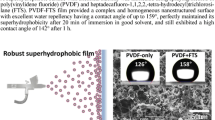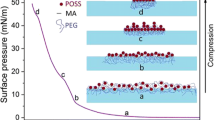Abstract
A superhydrophobic film with high water vapor transmission has been prepared via a vapor-induced phase separation process, where a block copolymer micellar solution was exposed to an organic non-solvent vapor atmosphere to evaporate solvent. After complete evaporation of the solvents, the obtained film displays 3-dimentional network with bi-continuous matrices and channels, both of which are at the scale of nanometers to micrometers. Interestingly, the matrix of the film consists of inter-connected sub-micrometer particles. The special hierarchical microstructure results in superhydrophobic and high adhesive properties of the film. Films with this kind of microstructure coating on non-planar substrates have been successfully prepared. The porosity of the film has been determined, and applications of the film in fields such as water vapor transmission and microfiltration separation have been carried out in order to indicate its potential.










Similar content being viewed by others
References
Lee HJ, Jung B, Kang YS, Lee H (2004) Phase separation of polymer casting solution by nonsolvent vapor. J Membr Sci 245:103–112
Khare VP, Greenberg AR, Krantz WB (2005) Vapor-induced phase separation-effect of the humid air exposure step on membrane morphology Part I. Insights from mathematical modeling. J Membr Sci 258:140–156
Yip Y, McHugh AJ (2006) Modeling and simulation of nonsolvent vapor-induced phase separation. J Membr Sci 271:163–176
Menut P, Su YS, Chinpa W, Pochat-Bohatier C, Deratani A, Wang DM, Huguet P, Kuo CY, Lai JY, Dupuy C (2008) A top surface liquid layer during membrane formation using vapor-induced phase separation (VIPS) - Evidence and mechanism of formation. J Membr Sci 310:278–288
Peinemann KV, Abetz V, Simon PFW (2007) Asymmetric superstructure formed in a block copolymer via phase separation. Nat Mater 6:992–996
Bouyer D, Werapun W, Pochat-Bohatier C, Deratani A (2010) Morphological properties of membranes fabricated by VIPS process using PEI/NMP/water system: SEM analysis and mass transfer modeling. J Membr Sci 349:97–112
Tsai JT, Su YS, Wang DM, Kuo JL, Lai J, Deratani A (2010) Retainment of pore connectivity in membranes prepared with vapor-induced phase separation. J Membr Sci 362:360–373
Rangou S, Buhr K, Filiz V, Clodt JI, Lademann B, Hahn J, Jung A, Abetz V (2014) Self-organized isoporous membranes with tailored pore sizes. J Membr Sci 45:266–275
Zhao N, Xie QD, Weng LH, Wang SQ, Zhang XY, Xu J (2005) Superhydrophobic surface from vapor-induced phase separation of copolymer micellar solution. Macromolecules 38:8996–8999
Zhao N, Xu J, Xie QD, Weng LH, Guo XL, Zhang XL, Shi LH (2005) Fabrication of biomimetic superhydrophobic coating with a micro-nano-binary structure. Macromol Rapid Commun 26:1075–1080
Venault A, Chang Y, Wang DM, Bouyer D (2013) A review on polymer membranes and hydrogels prepared by vapor-induced phase separation process. Polymer Rev 53:568–626
Zhao N, Zhang XY, Zhang XL, Xu J (2007) Simultaneous tuning of chemical composition and topography of copolymer surfaces: micelles as building blocks. ChemPhysChem 8:1108–1114
Tan SX, Xie QD, Lu XY, Zhao N, Zhang XL, Xu J (2008) One step preparation of superhydrophobic polymeric surface with polystyrene under ambient atmosphere. J Colloid Interf Sci 322:1–5
Yuan ZQ, Chen H, Tang JX, Zhao DJ (2009) A stable porous superhydrophobic high-density polyethylene surface prepared by adding ethanol in humid atmosphere. J Appl Polym Sci 113:1626–1632
Erbil HY, Demirel AL, Avci Y, Mert O (2003) Transformation of a simple plastic into a superhydrophobic surface. Science 299:1377–1380
Han JT, Xu XR, Cho K (2005) Diverse access to artificial superhydrophobic surfaces using block copolymers. Langmuir 21:6662–6665
Yuan ZQ, Chen H, Tang JX, Chen X, Zhao DJ, Wang ZX (2007) Facile method to fabricate stable superhydrophobic polystyrene surface by adding ethanol. Surf Coat Technol 201:7138–7142
Aruna ST, Binsy P, Richard E, Basu BJ (2012) Properties of phase separation method synthesized superhydrophobic polystyrene films. Appl Surf Sci 258:3202–3207
Wang XY, Weiss RA (2012) A facile method for preparing sticky, hydrophobic polymer surfaces. Langmuir 28:3298–3305
Xiong XP, Eckelt J, Wolf BA, Zhang ZJ, Zhang L (2006) Continuous spin fractionation and characterization by GPC for styrene-butadiene block copolymers. J Chromatogr A 1110:53–60
Lodge TP (2003) Block copolymers: past successes and future challenges. Macromol Chem Phys 204:265–273
Xiong XP, Zou WW, Lin MF (2010) Effect of molecular architecture on self-assembly of SBS block copolymers in selective solvent. J Funct Mater 41:1265–1267
Xiong XP (2011) Effect of molecular architecture on morphology SBS block copolymers in solution. Acta Polym Sin 1:76–80
Li XM, Reinhoudt D, Crego-Calama M (2007) What do we need for a superhydrophobic surface? A review on the recent progress in the preparation of superhydrophobic surfaces. Chem Soc Rev 36:1350–1368
Liu KS, Tian Y, Jiang L (2013) Bio-inspired superoleophobic and smart materials: design, fabrication, and application. Prog Mater Sci 58:503–564
Xiong XP, Zou WW, Yu ZJ, Duan JJ, Liu XJ, Fan SH, Zhou H (2009) Microsphere pattern prepared by a “reverse” breath figure method. Macromolecules 42:9351–9356
Bunz UHF (2006) Breath figures as a dynamic templating method for polymers and nanomaterials. Adv Mater 18:973–989
Xiong XP, Lin MF, Zou WW (2011) Honeycomb structured porous films prepared by the method of breath figure: history and development. Curr Org Chem 15:3706–3718
Kang DE, Byeon SJ, Heo MS, Moon BK, Kim I (2014) Fabrication of ordered honeycomb structures and microspheres using polystyrene-block-poly(tert-butyl acrylate) star polymers. J Polym Res 21:382
He MJ, Chen XW, Dong XX (1999) Polymer physics, revised edition, Fudan University press, Shanghai, China, (Chapter 3)
Feng L, Zhang YN, Xi JM, Zhu Y, Wang N, Xia F, Jiang L (2008) Petal effect: a superhydrophobic state with high adhesive force. Langmuir 24:4114–4119
Bhushan B, Nosonovsky M (2010) The rose petal effect and the modes of superhydrophobicity. Phil Trans R Soc A 368:4713–4728
Liu MJ, Zeng YM, Zhai J, Jiang L (2010) Bioinspired super-antiwetting interfaces with special liquid-solid adhesion. Acc Chem Res 43:368–377
Acknowledgments
This work was financially supported by the Natural Science Foundation of Fujian Province of China (No. 2013 J01206), the Natural Science Foundation of China (No. 51273166) and the Fundamental Research Funds for the Central Universities of China (CXB2014014).
Author information
Authors and Affiliations
Corresponding author
Rights and permissions
About this article
Cite this article
Ke, Q., Liao, Y., Lin, M. et al. A superhydrophobic film with high water vapor transmission prepared from block copolymer micelle solution via VIPS method. J Polym Res 22, 213 (2015). https://doi.org/10.1007/s10965-015-0850-z
Received:
Accepted:
Published:
DOI: https://doi.org/10.1007/s10965-015-0850-z




